December 2015 Economic Forecast: On The Low End Of The Growth Seen Since The End Of The Great Recession
Econintersect's Economic Index declined - and remains in the low range of index values seen since the end of the Great Recession. The most tracked sectors of the economy generally showed some growth. Still our economic index remains in a long term decline since late 2014.

Our employment six month forecast discussed below continues to forecast weakening employment growth.
- The consumer portion of the economy continues to outperform the business sector.
- Income growth is finally exceeding expenditures. Still consumers continue to spend a historically high percentage of income - and there seems to be little room for improvement in the rate of spending growth. Note that the quantitative analysis which builds our model does not include personal income or expenditures directly.
- Another data point - the correlation between retail sales and employment is in recessionary territory - even with the big employment number in October. Note that neither employment nor retail sales are part of our economic model.
- Econintersect checks its forecast using several alternate monetary based methods - and all the checked forecasts show moderate to weak economic growth.
- Note that all the graphics in this post auto-update. The words are fixed on the day of publishing, and therefore you might note a conflict between the words and the graphs due to backward data revisions and/or new data which occurs during the month.
This post will summarize the:
- special indicators,
- leading indicators,
- predictive portions of coincident indicators,
- review of the technical recession indicators, and
- interpretation of our own index - Econintersect Economic Index (EEI) - which is built of mostly non-monetary "things" that have been shown to be indicative of direction of the Main Street economy at least 30 days in advance.
Special Indicators:
The consumer is still consuming. The ratio of spending to income is again over 0.92 - and has been elevated since Jan 2013. There have been only four periods in history where the ratio of spending to income has exceeded 0.92 (April 1987, the months surrounding the 2001 recession, from September 2004 to the beginning of the 2007 Great Recession, and for some occasions since late 2013). A high ratio of spending to income acts as a constraint to any major expansion in consumer spending.
Seasonally Adjusted Spending's Ratio to Income (a increasing ratio means Consumer is spending more of Income)

The St. Louis Fed produces a Smoothed U.S. Recession Probabilities Chart which is currently giving no indication of a recession.
Smoothed recession probabilities for the United States are obtained from a dynamic-factor markov-switching model applied to four monthly coincident variables: non-farm payroll employment, the index of industrial production, real personal income excluding transfer payments, and real manufacturing and trade sales. This model was originally developed in Chauvet, M., "An Economic Characterization of Business Cycle Dynamics with Factor Structure and Regime Switching," International Economic Review, 1998, 39, 969-996. (http://faculty.ucr.edu/~chauvet/ier.pdf)
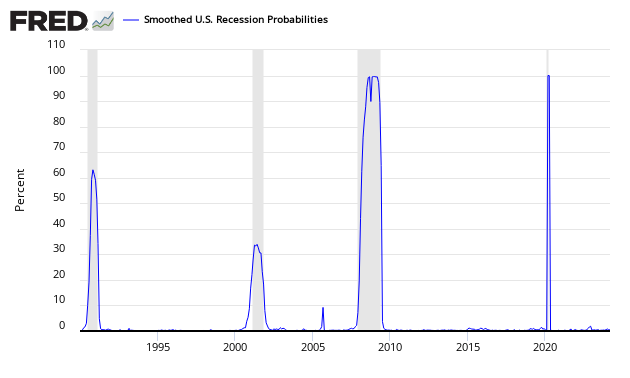
Joe Sixpack's economic position is better than the previous period (blue line in graph below). The Econintersect index's underlying principle is to estimate how well off Joe feels. The index was documented at a bottom in the July 2012 forecast. Joe and his richer friends are the economic drivers. Joe's position is above levels associated with past recessions. However, note that this index has falsely warned of recessions that never occurred - but its purpose is not to foresee recession, but to indicate stress on the consuming class. This index is updated every quarter. It could also be said that GDP has divorced itself from Joe Sixpack.
Joe Sixpack Index (blue line, left axis):
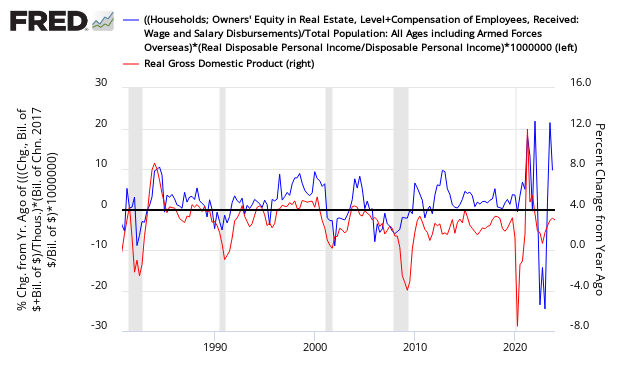
Econintersect reviews the relationship between the year-over-year growth rate of non-farm private employment and the year-over-year real growth rate of retail sales.This index is currently negative. When retail sales grow faster than the rate of employment gains (above zero on the below graph) - a recession is not imminent. However, this index has many false alarms.
Growth Relationship Between Retail Sales and Non-Farm Private Employment - Above zero suggests economic expansion
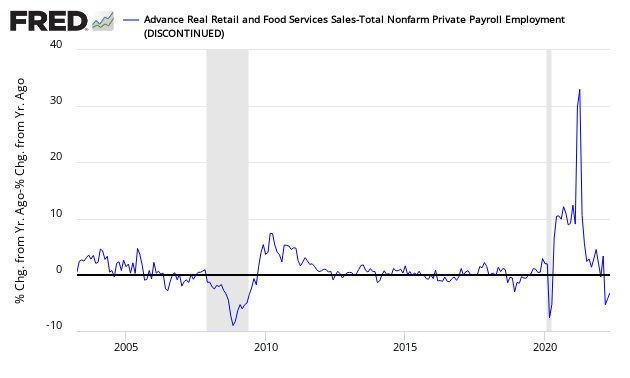
The growth rate of real gross domestic product (GDP) is the headline view of economic activity, but the official estimate is released with a delay. Atlanta's Fed GDPNow forecasting model provides a "nowcast" of the official estimate prior to its release. Econintersect does not believe GDP is a good tool to view what is happening at Main Street level - but there are some correlations. In the previous 30 days, GDPnow is forecasting a declining rate of growth.

- Most economic releases are based on seasonally adjusted data which are revised for months after issuance. An actual contraction in a particular release may not be obvious for many months due to seasonality methodology which smooths the data. Special indicators are not particularly strong - and now shows a weaker economy.
The Leading Indicators:
The leading indicators are for the most part monetary based. Econintersect's primary worry in using monetary based methodologies to forecast the economy is the current extraordinary monetary policy which may (or may not) be affecting historical relationships.
Econintersect does not use data from any of the leading indicators in its economic index. Leading indices in this post look ahead six months - and are all subject to backward revision.
Chemical Activity Barometer (CAB) - The CAB is an exception to the other leading indices as it leads the economy by two to fourteen months, with an average lead of eight months. The CAB is a composite index which comprises indicators drawn from a range of chemicals and sectors. It is a relatively new index and appears remarkably accurate (but its real time performance is unknown - you can read more here). A value above zero is suggesting the economy is expanding.

ECRI's Weekly Leading Index (WLI) - A positive number shows an expansion of the business economy, while a negative number is contraction. The methodology used in created this index is not released but is widely believed to be monetary based.
Current ECRI WLI Index
The Conference Board's Leading Economic Indicator (LEI) - the LEI has historically dropped below zero in its six-month moving average anywhere between 2 to 15 months before a recession.

Leading Index for the United States from the Philadelphia Fed - This index is the super index for all the state indices.
The leading index for each state predicts the six-month growth rate of the state's coincident index. In addition to the coincident index, the models include other variables that lead the economy: state-level housing permits (1 to 4 units), state initial unemployment insurance claims, delivery times from the Institute for Supply Management (ISM) manufacturing survey, and the interest rate spread between the 10-year Treasury bond and the 3-month Treasury bill.
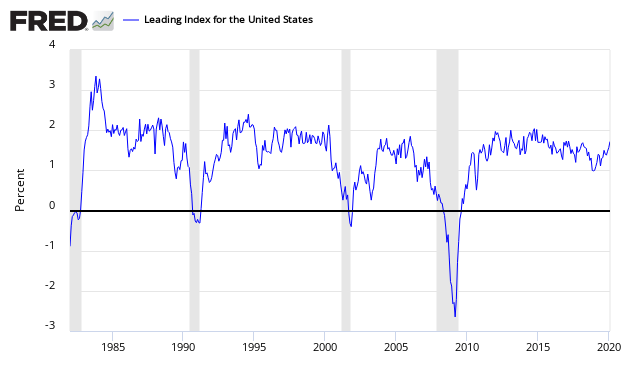
Nonfinancial leverage subindex of the National Financial Conditions Index - a weekly index produced by the Chicago Fed signals both the onset and duration of financial crises and their accompanying recessions. Econintersect now believes this index may be worthless in real time as the amount of backward revision is excessive - so we present this index for information only. This index was designed to forecast the economy six months in advance. The chart below shows the current index values, and a recession can occur months to years following the dotted line below crossing above the zero line.

Leading Indicators Bottom Line - are generally saying growth will be improving over the next six months:
- Chemical Activity Barometer (CAB) growth rate has slowed..
- ECRI's WLI is now forecasting literally no growth growth in the business cycle six months from today.
- The Conference Board (LEI) 6 month rolling average is indicating an slowing rate of growth over the next 6 months.
- The Philly Fed's Leading Index continues to forecast stable but slowing rate of growth.
- The Chicago Fed's Nonfinancial leverage subindex is not close to warning a recession.
Forward Looking Coincident Indicators
Here is a run through of the most economically predictive coincident indices whichEconintersect believes can give up to a six month warning of an impending recession - and do not have a history of producing false warnings. Econintersectdoes not use any of these indicators in its economic forecast.
Consider that every recession has different characteristics - and a particular index may not contract during a recession, or start contracting after the recession is already underway.
Truck transport portion of employment - to search for impending recessions. Look at the year-over-year zero growth line. For the last two recessions it has offered a six month warning of an impending recession with no false warnings. Transport is an economic warning indicator because it moves goods well before final retail sales occur. Until people stop eating or buying goods, transport will remain one of the primary economic pulse points.
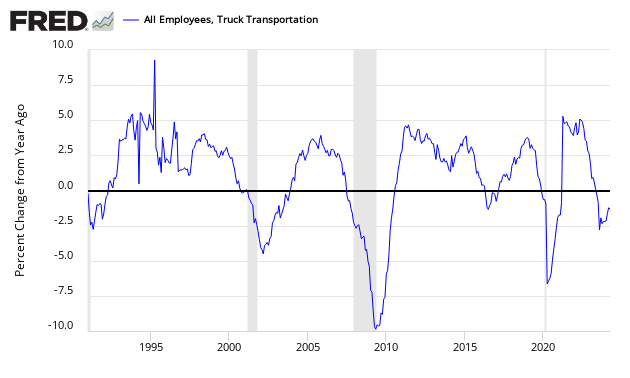
Transport employment growth remains well above the zero growth line - with a short term trend now showing marginal deceleration. As transport provides a six month recession warning - the implication is that any possible recession is further than six months away.
Business Activity sub-index of ISM Non-Manufacturing - this index is noisy. The index continues to remain over 60 (below 55 is a warning that a recession might occur, whilst below 50 is almost proof a recession is underway).

Predictive Coincident Index Bottom Line - No predictive index is warning of a recession.
- True economic activity (not monetary based GDP) was expanding in the most recent hard economic data shows growth around 2.0 % in many sectors of the economy using non-monetary pulse points based on these indices shown above, and other indices which Econintersect are indicative of the real economy.
- Overall the coincident data is remains fairly positive with the ISM non-manufacturing subindex is at average levels for periods of economic expansion whilst the truck transport growth is also around average levels for periods of economic expansion.
Technical Requirements of a Recession
Sticking to the current technical recession criteria used by the NBER:
A recession is a significant decline in economic activity spread across the economy, lasting more than a few months, normally visible in real GDP, real income, employment, industrial production, and wholesale-retail sales. A recession begins just after the economy reaches a peak of activity and ends as the economy reaches its trough. Between trough and peak, the economy is in an expansion. Expansion is the normal state of the economy; most recessions are brief and they have been rare in recent decades.
….. The committee places particular emphasis on two monthly measures of activity across the entire economy: (1) personal income less transfer payments, in real terms and (2) employment. In addition, we refer to two indicators with coverage primarily of manufacturing and goods: (3) industrial production and (4) the volume of sales of the manufacturing and wholesale-retail sectors adjusted for price changes.
Below is a graph looking at the month-over-month change (note that multipliers have been used to make changes more obvious).
Month-over-Month Growth Personal Income less transfer payments (blue line), Employment (red line), Industrial Production (green line), Business Sales (orange line)
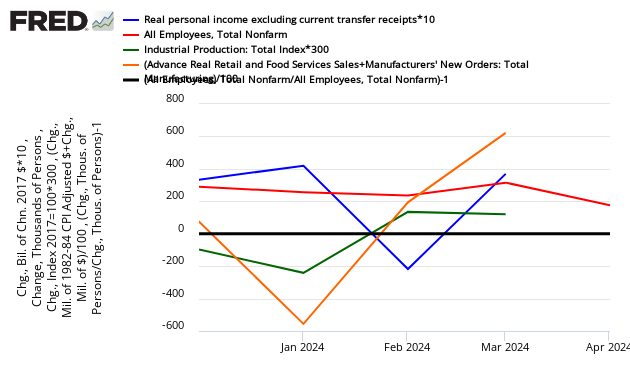
In the above graph, if a line falls below the 0 (black line) - that sector is contracting from the previous month. At his point,much of the data is soft. Again, this is a rear view mirror, is subject to revision, and is not predictive of where the economy is going. Another way to look at the same data sets is in the graph below which uses indexed real values from the trough of the Great Recession.
Indexed Growth Personal Income less transfer payments (red line), Employment (green line), Industrial Production (blue line), Business Sales (orange line)
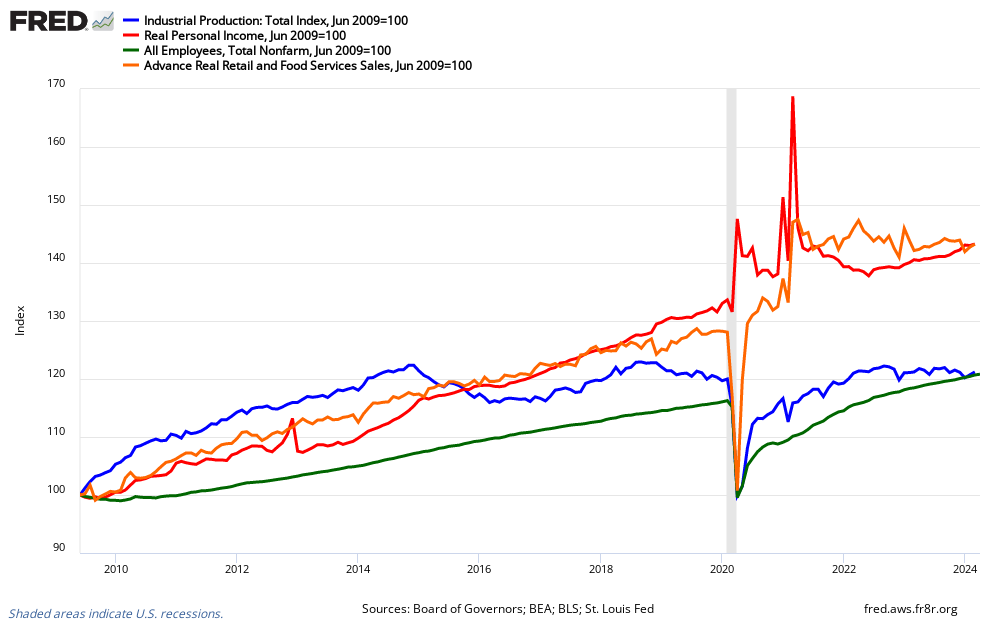
NBER Recession Marker Bottom Line - The data sets used by the NBER are relatively weak with industrial production and business sales in the warning zone..
Economic Forecast Data
The Econintersect Economic Index (EEI) is designed to spot Main Street and business economic turning points. This forecast is based on the index's three month moving average. The three month rolling index value is now unchanged. As a summary:
- The government portion relating to business and main street continues to show weak growth.
- The business portion is weak.
- The consumer portion is relatively stronger than the other sectors.
The EEI is a non-monetary based economic index which counts "things" that have shown to be indicative of direction of the Main Street economy at least 30 days in the future. Note that the Econintersect Economic Index is not constructed to mimic GDP (although there are correlations, but the turning points may be different), and tries to model the economic rate of change seen by business and Main Street. The vast majority of this index uses data not subject to backward revision.
Econintersect Economic Index (EEI) with a 3 Month Moving Average (red line)
z forecast1.PNG
The red line on the EEI is the 3 month moving average which is at 0.21 (down from last month's 0.32). The economic forecast is based on the 3 month moving average as the monthly index is very noisy. Readings below 0.4 indicate a weak economy, while readings below 0.0 indicate contraction.

The 3 month rolling average EEI for the last 12 months has been in a range between 0.20 and 0.61 - and the current index is in the lower part of the range. A positive value of the index represents main street economic expansion.
Consumer and business behavior (which is the basis of the EEI) either lead or follow old fashion industrial age measures such as GDP depending on the primary dynamic(s) driving the economy. The main street sector of the economy lagged GDP in entering and exiting the 2007 Great Recession.
As Econintersect continues to back check its model, from time-to-time slight adjustments are made to the data sets and methodology to align it with the actual coincident data. To date, when any realignment was done, there have been no changes for trend lines or recession indications. Most changes to date were to remove data sets which had unacceptable backward revisions or were discontinued. There has been no realignment done in the last 3 years. Documentation for this index was in the October 2011 forecast.
Jobs Growth Forecast Declines
The Econintersect Jobs Index is forecasting non-farm private jobs growth of 120,000 for November - down from last month's 130,000 forecast. The fundamentals which lead jobs growth have been moderately decelerating this year. However, there are currently dynamics in play where we are forecasting better growth next year.
Comparing BLS Non-Farm Employment YoY Improvement (blue line, left axis) with Econintersect Employment Index (red line, left axis) and The Conference Board ETI (yellow line, right axis)

employment_indices.png
The Econintersect Jobs Index is based on economic elements which create jobs, and (explanation here) measures the historical dynamics which lead to the creation of jobs. It measures general factors, but it is not precise (quantitatively) as many specific factors influence the exact timing of hiring. This index should be thought of as a measurement of jobs creation pressures.
For the last year, jobs growth year-over-year (green line in below graph) is averaging between the levels forecast by the Econintersect Jobs Index (blue line in below graph), and a fudged forecast (red line in below graph) based on deviation between forecast & current actual using a 3 month rolling average.
Econintersect Employment Forecast (blue line), Fudged Forecast (red line), and BLS Non-Farm Jobs Month-over-Month Growth (green line)
z forecast2.PNG
The fudge factor (based on deviation between the BLS actual growth and the Econintersect Employment Index over the last 3 months) would project December jobs growth at 160,000 - down from the 145,000 forecast for last month. This fudge factor is fluid (subject to change) as the BLS has significant backward revision to their jobs numbers.
Analysis of Economic Indicators:
Econintersect analyzes all major economic indicators. The table below contains hyperlinks to posts. The right column "Predictive" means this particular indicator has a leading component (usually other then the index itself) - in other words has a good correlation to future economic conditions.
General Economic Indicators:
Monthly Data: {click here to view full screen}
Quarterly Data: {click here to view full screen>}
Aruoba-Diebold-Scotti Business Conditions Index: {click here to view full screen}
Disclosure: None.






